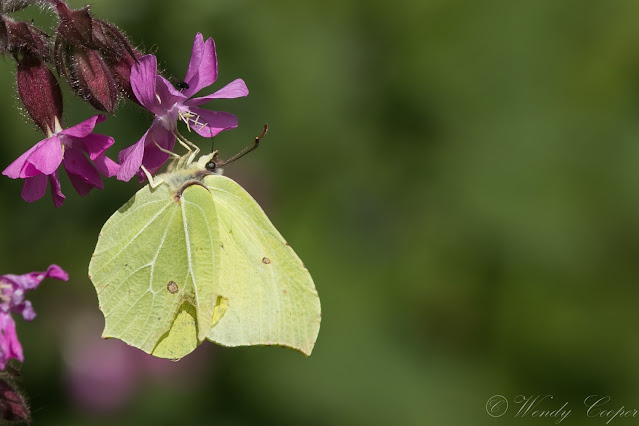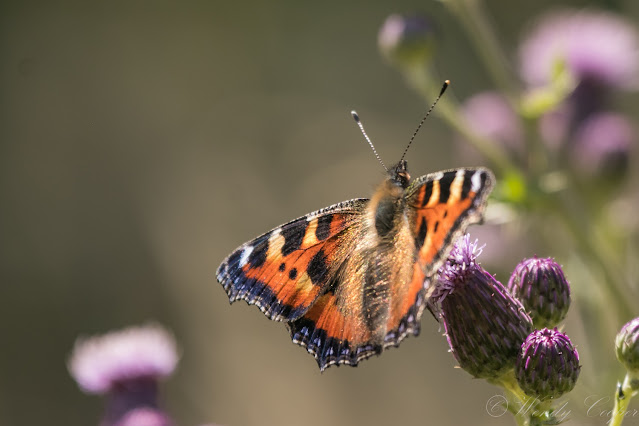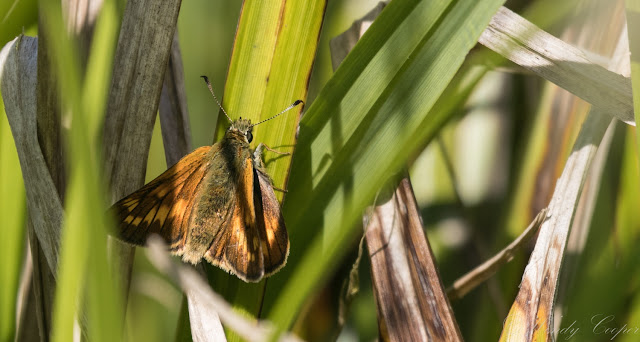All A-Flutter!
Well
Hello ! it's been a while, but I have been out and about and have finally
gotten round to starting to catch up here though!
These are day flying in sunshine or when it is warm and overcast and are easily disturbed from low vegetation. Whilst I was watching I also saw at least one Mother Shipton moth, (so called because of the witch's face on the wing) however, none were accessible for even a record shot! As I carried on peering in the grasses, a blue fast flutter caught my eye - a rare sighting on the patch of a Common Blue!
Around five years ago, there were reasonable sized colonies of both Common Blue and Brown Argus butterflies in the meadow, however, three years ago (as part of some kind of land management) the meadow was mown at the end of July, with not a blade of grass or wildflower left standing. The cuttings were all burnt and there was no second brood of butterflies that year; as neither colony ever recovered sightings of these tiny delicate butterflies are now scarce.
Eggs would be laid on whatever preferred food plants are available for the caterpillars - red or white clovers or trefoils, once the caterpillar reaches the chrysalis stage, this is formed on the ground and as with some of the other Lycaenidae species, may on occasion be tended by ants. Ants may also take a chrysalis into an ant nest, where the half grown butterfly will hibernate - rent is paid though, as the butterfly produces honeydew, which the ants feed on!
These are often seen patrolling busily along banks of brambles or other vegetation and rarely seem to stop for long. As I reached the top of the path by the road, along the fence, there were a number of thistle heads in bloom, with Small White butterflies, Meadow Browns, Small Heath and Small Tortoisehells all taking advantage of the available nectar.
The Meadow Browns usually roost in the grasses, both here and in the meadow, flying up and about at the slightest disturbance. On one side of me they were fluttering through the grasses and on the other, competing with the other species for a free space of a thistle head. When I walked around the meadow later that afternoon and over the next few weeks, the Meadow Browns would also be roosting in the grasses there and would be found nectaring on thistles occasionally although they seemed to favour the bramble blooms more.
I don't often see these, maybe one or two a year, in one location or another on my patch, if at all. Last year, for a few weeks, there was one maintaining it's territory at the edge of the oat crop, this year they have grown beans, so this one had appeared in a more favourable habitat. When seen, they are always close to the ground and seem to prefer grassy areas, whilst widespread, they are causing concern as their numbers have dropped.
Just
across the path, which is a grassier area, there were quite a few Small
Skippers flitting around in the grasses and occasionally nectaring on the
thistles as well.
These like grassy areas and in the meadow I also saw reasonable numbers of these as well as Essex and Large Skippers.
Large Skipper
These will nectar on brambles, thistles and also vetch or trefoil and lay their eggs in the grasses; indeed where hay is transported and then the bales broken for feed in fields, is one way that these have become widespread, through their eggs travelling long distance in the hay!
After a while they both flew off dancing, presumably to find a suitable spot for the next stage of their courtship.
Around the woodland edges and also within in sunny spots through the tree canopy, I have seen quite a few Speckled Wood Butterflies. These are great to watch, fluttering up and about and determinedly defending their spot. One afternoon, I spent some time in a sunlit spot in the woods watching one that was seeing off allcomers including a stray Ringlet that was taking some shade from the blazing meadow (it was that warm, even the squirrels were walking that afternoon!)
Out in the meadow, there were a fair few Meadow Browns, Small Whites and Ringlets throughout the grasses in addition to a good number of assorted Skippers.
The Ringlets, as do the Meadow Browns, made good use of the brambles and available nectar and late in the afternoons, if watched carefully, could be seen roosting low down in the grasses. Here and there around the meadow, particularly around the thistles, I also had been seeing quite a few Five and Six Spot Burnet moths.
These striking day flying moths are a warning to predators of 'not to eat' as they are very toxic. One day flier I haven't seen this year is the Cinnabar moth, also black and scarlet, however I have seen quite a few of their striking orange stripey caterpillars feeding on Ragwort.
One
afternoon in July, I was coming to the end of my walk and was watching a Comma
as it tried to decide on a spot to perch on a big bank of brambles under the
eaves of some Oak trees.
All of a sudden, a much larger beautifully marked butterfly flew out of the woods and settled on the brambles. I did a double take - this beauty was a Silver Washed Fritillary!
Now, not only had I never seen any of the Fritillaries before, I had also never seen one of these on the local patch; once I'd got home and identified it from my photo's, well, there was a bit of dancing at the pc!. Anyway, these are woodland butterflies, favouring sunny grassy clearings with nectar rich brambles to feed and shadier areas to breed. They are extremely eyecatching and beautifully marked, as well as being fast fliers. This is the most common colouration of them, although in some parts of the country the females are a bronze/green colouring, known as the valezina form.
A
few weeks later, a good number of fresh Gatekeepers emerged, both around the
bramble banks in the meadow and on the little patch up by the road.
With wings closed, they look a little like small Meadow Browns, however, I tell them apart by size and also the two tiny white spots in the black dot on their wing. There were a good number of these around, both in the meadow and even in the 'new planting' part of the woods. They were good to watch as they chased potential mates around or simply settled to bask or nectar.
I have seen very tired looking Painted Ladies around the field after the harvest before and even one last year in the same spot, but never this new! These butterflies seem to have a continuous mating cycle, so that they reproduce as they migrate in waves; this pair then, were most likely the progeny of arrivals earlier in the summer.
Painted
Ladies are long distance migrants, starting in North Africa and gradually
reaching the UK, sometimes their arrival across the south coast here has been
on the spectacular side and some years are better than others for seeing them.
They are not thought to overwinter here and high altitude surveys have noted
autumn migrations back to warmer climes.
These
seem to have had a particularly good year here, with quite a few seen all over
the patch, either around the woodland margins, occasionally on brambles, the
one which regularly frequented my back garden for a few weeks or the one above
on a young Oak tree.



























